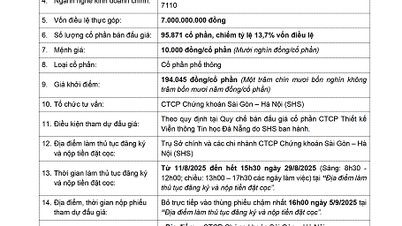 |
| The baby was born in the hospital. Photo: VNN |
The recent regulation that party members who have three or more children will not be subject to disciplinary action is considered an important and positive change in population policy. Many policies have been and are being revised to encourage people to have children.
One young person taking care of six elderly people
According to population experts, economic , work, and housing pressures have forced many couples of childbearing age to consider when deciding to have children. The birth rate has been particularly low in large cities and industrial parks - where the high cost of raising children has made many families uninterested and reluctant to have children. Many couples, even after being married for more than 3 years, still have no intention of having children. This trend has pushed Vietnam's birth rate in 2024 to its lowest in history.
According to the General Statistics Office, from 2019 to 2024, Vietnam's population will increase by nearly 1 million people each year, down from 1.22% in the 2014-2019 period. Studies by the Ministry of Health also show that Vietnam's replacement fertility rate is falling at its sharpest rate in the past 12 years. In 2023-2024, the birth rate showed signs of rapid decline. In 2023, Vietnam's total fertility rate was 1.96 children/woman. Although 2024 is considered a "good year" (the year of the dragon Giap Thin), the birth rate not only did not increase but continued to decrease, reaching its lowest level ever at 1.91 children/woman.
Explaining this reason, the Ministry of Health said that improved living conditions and increasing educational levels have made many people, especially young couples, focus on developing their careers and finding good jobs to ensure income and improve their quality of life. In addition, economic pressure on young families is increasing, especially the cost of living, raising and educating children from birth to adulthood, so many couples are reluctant to have children.
Prof. Dr. Nguyen Dinh Cu, former Director of the Institute of Population and Social Issues - National Economics University (Hanoi), said that the reality from many countries in the world such as Japan, Korea, China, Europe... shows that when the birth rate has decreased, it is difficult to increase again. If Vietnam does not soon have timely policies, the birth rate will continue to decrease in the following years. “Many developed countries have a low birth rate for a long time, each couple does not have enough 2 children, which has caused population decline, severe labor shortage and turned into a country with a super-aged population, causing many consequences. The “4-2-1 syndrome” has appeared at the family level, meaning 4 grandparents; 2 parents and 1 child. With this model, when a child is young, they are taken care of by 6 people, but when they grow up, they have to take care of 6 elderly people. This situation is not only disadvantageous for the child's maturity but also for the family's quality of life,” Mr. Cu explained.
 |
| Ho Chi Minh City medical team provides free medical examination and medicine to people in three communes: Son Long, Son Xuan, Son Dinh (Son Hoa district). Photo: MANH LE TRAM |
Concerns about the aging population
Analyzing the trend of having few children, Prof. Dr. Nguyen Dinh Cu said that the reproductive model in Vietnam is shifting from quantity to quality, meaning from having many children, low quality, to having few children, high quality. To have healthy, well-educated children, of course, the cost must be high. A survey on low birth rates in the South in 2019 showed that more than 90% of parents assessed the cost of raising children as expensive or very expensive. Meanwhile, by 2024, the average income of workers will only reach 7.7 million VND/month. In this context, having 2 children is a big challenge for many people.
According to Mr. Cu, nowadays many young couples have little time and conditions to take care of their children. They have many aspirations for advancement in education, skills, social status, and increased income... That is the fundamental reason leading to the trend of having few children, even being afraid to have children.
A child growing up not only brings benefits and happiness to the family but also becomes a soldier to protect the Fatherland, a worker for society, and a builder of the country. Therefore, the State and the community's responsibility to share the cost of raising children is not only deeply humane but also reasonable, considering the costs and benefits.
Prof. Dr. Nguyen Dinh Cu
The Ministry of Health forecasts that in the 2019-2069 period, if the birth rate decreases sharply as in the low scenario, after 2054, Vietnam's population will begin to experience negative growth and the decrease will become larger and larger. In the 2054-2059 period, the population will decrease by an average of 0.04% per year and the decrease at the end of the forecast period (2064-2069) will be 0.18% per year - equivalent to a decrease of 200,000 people per year. On the contrary, if the replacement fertility rate remains stable throughout the forecast period, Vietnam's population will still increase slightly by the end of this period. On average, the population will increase by 0.17% per year in the 2064-2069 period, equivalent to 200,000 people per year. This scenario, with the current trend of decreasing birth rates, is unlikely to occur.
According to the instructions of the Central Inspection Commission, from March 20, 2025, Party members who have a third child will no longer be subject to disciplinary action. This, along with a series of changes in population policy to promote fertility, is considered by many population experts to be a correct and appropriate policy, based on domestic practice and international experience. This is considered a flexible, humane and timely move, in the context of Vietnam facing major population challenges.
In order to make the birth promotion to increase the birth rate sustainable, Prof. Dr. Nguyen Dinh Cu said that there should be measures to support families to reduce the cost of raising children. There are many forms of sharing these costs, such as: Childbirth allowance, free tuition from preschool to high school; exemption and reduction of personal income tax; exemption/reduction of contributions in the community; housing support policies...
In addition, develop a system of family and children services, such as: nursery system, education, food processing, entertainment...; provide financial support for couples with infertility treatment.
In Phu Yen, the Department of Health continues to implement Conclusion 149-KL/TW dated April 10, 2025 of the Politburo on continuing to promote the implementation of Resolution 21-NQ/TW dated October 25, 2017 of the 6th Conference of the 12th Party Central Committee on population work in the new situation.
Regarding the regulation that party members who have a third or more child are not subject to disciplinary action, according to Mr. Pham Minh Huu, Director of the Department of Health, the National Assembly Standing Committee issued an Ordinance amending Article 10 of the 2003 Population Ordinance. Article 10: Rights and obligations of each couple and individual in implementing the population-family planning campaign and reproductive health care. The law stipulates the rights and obligations of couples and individuals in giving birth; measures to maintain replacement fertility; allowing couples and individuals to decide on the time of giving birth, the number of children and the interval between births (different from Article 10 of the 2003 Population Ordinance, amended and supplemented in 2008). In the draft Population Law currently seeking public opinion, the Ministry of Health proposes to allow female workers who have a second child to extend their maternity leave from 6 months to 7 months.
Source: https://baophuyen.vn/xa-hoi/202505/tang-muc-sinh-ung-pho-gia-hoa-dan-so-a870dbd/




































































































Comment (0)